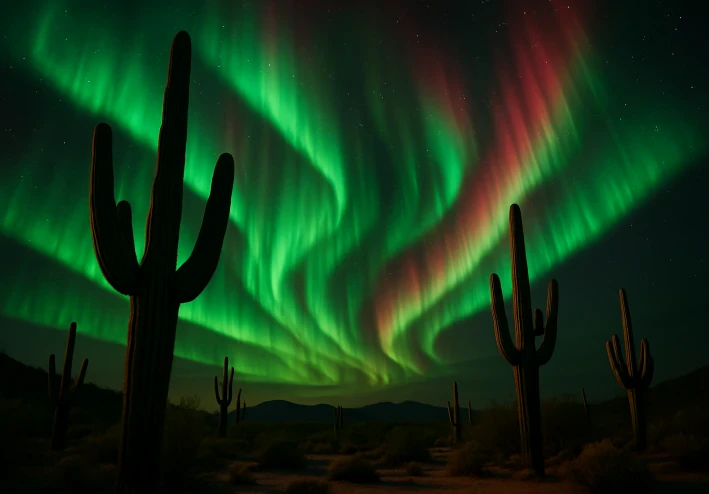
The Great American Aurora: A Deep Dive into the G4 Storm That Painted the Skies from Arizona to the Atlantic
The Great American Aurora: A Deep Dive into the G4 Storm That Painted the Skies from Arizona to the Atlantic
Prologue: The Night the Sky Came South – A Celestial Invasion
For two consecutive nights in November 2025, the celestial curtain of the Northern Lights, the Aurora Borealis, descended from its Arctic stage anي performed a dazzling, unprecedented show across the American heartland. From the high deserts of Arizona to the suburban sprawl of the Washington D.C. area, millions of Americans who had only ever dreamed of the aurora were suddenly thrust into the role of sky-watchers. This was not a faint, ghostly shimmer on the northern horizon; this was a vibrant, multi-hued spectacle, a direct consequence of one of the most powerful solar events of the current cycle: a Severe (G4) Geomagnetic Storm.
The sheer geographic reach of this event—illuminating the skies over places like Perry, Kansas, and the Driftless Region of Wisconsin—has rewritten the rules of aurora visibility. It has sparked a national conversation, dominating news cycles and social media feeds, and turning every local weather report into a space weather bulletin. This deep-dive investigation seeks to understand the magnitude of this event, the complex science that drove it, the localized impact across the United States, and the enduring legacy of the Great American Aurora. We will delve into the history of these solar phenomena, the precise mechanics of the G4 storm, the unique regional experiences reported by the media, and the critical lessons learned by a nation of newly minted aurora chasers.
Chapter I: The Solar Fury – The Mechanics of a G4 Storm and the History of Solar Events

The story of the aurora begins 93 million miles away, on the surface of our star, the Sun. The event that triggered this spectacle was a massive eruption known as a Coronal Mass Ejection (CME). To truly grasp the significance of the November 2025 event, we must first understand the violent, cyclical nature of the Sun and the history of its most powerful outbursts.
The Anatomy of a Coronal Mass Ejection (CME)
A CME is not a solar flare, though the two often occur together. A solar flare is a burst of intense electromagnetic radiation, traveling at the speed of light, which reaches Earth in minutes and can cause immediate radio blackouts. A CME, however, is a colossal cloud of magnetized plasma—charged particles, primarily electrons and protons—that is violently ejected from the Sun's corona. This cloud travels much slower, typically taking between one and four days to reach Earth, but it carries a far greater mass and magnetic punch.
In the case of the November 2025 event, the CME was both massive and directed squarely at Earth, a "direct hit" or "halo CME." Its arrival was predicted by the NOAA Space Weather Prediction Center (SWPC), which issued a rare G4 (Severe) Geomagnetic Storm Watch. The speed of this particular CME was a critical factor; the faster the plasma cloud travels, the more intense the shockwave it creates upon impacting Earth's magnetic field, leading to a more severe geomagnetic storm.
The Geomagnetic Storm Scale: Why G4 is a Landmark Event
The NOAA's G-scale, which measures the intensity of geomagnetic storms from G1 (Minor) to G5 (Extreme), is the universal metric for space weather. The G4 classification is a significant event, marking only the fourth time such a severe alert has been issued since the current Solar Cycle 25 began in 2019.
| Storm Level | Classification | Frequency (Approx. per 11-year cycle) | Potential Infrastructure Impacts | Aurora Visibility |
| G1 | Minor | 1700 | Weak power grid fluctuations, minor impact on satellite operations. | High latitudes (e.g., Canada, Alaska). |
| G2 | Moderate | 600 | High-latitude power system alarms, minor impact on HF radio. | Mid-latitudes (e.g., northern US states). |
| G3 | Strong | 200 | Voltage corrections needed, intermittent satellite navigation issues. | Mid-latitudes (e.g., northern and central US). |
| G4 | Severe | 100 | Widespread voltage control problems, possible protective system trips, surface charging on satellites. | Low latitudes (e.g., as far south as Arizona, D.C.). |
| G5 | Extreme | 4 | Widespread power blackouts, complete collapse of some grids, extensive satellite and radio problems. | Very low latitudes (e.g., Florida, Mexico). |
The storm's severity meant that the Earth's magnetic field, the magnetosphere, was compressed and distorted so violently that the charged particles were funneled much closer to the equator than is typical. This compression, combined with the southward orientation of the CME's magnetic field (a crucial factor known as Bz), allowed the aurora to be seen in states that rarely, if ever, experience the phenomenon. The energy deposited into the magnetosphere during this G4 event was immense, driving the auroral oval far beyond its normal boundaries.
Historical Context: The Carrington Event and the Modern Threat
The November 2025 G4 storm, while severe, pales in comparison to the most extreme solar event in recorded history: the Carrington Event of 1859. That event, estimated to be a G5 or higher, caused telegraph systems to fail, shocking operators and even setting some telegraph papers on fire. Auroras were reported as far south as the Caribbean and Hawaii.
The G4 event of 2025 serves as a modern-day "near-miss" and a critical reminder of our vulnerability. In our hyper-connected world, a G5 event today could cause trillions of dollars in damage, leading to long-term power outages, communication blackouts, and a complete disruption of satellite-dependent services like GPS and banking. The fact that the G4 storm caused only minor, manageable disruptions to infrastructure is a testament to modern grid hardening and the effectiveness of the SWPC's early warning system, which allowed utility companies to take precautionary measures.
Chapter II: The American Experience – Localized Impact and the Media Narrative

The widespread visibility of the aurora created distinct regional narratives, each grappling with the rarity of the event and the challenge of viewing it through local conditions. The three trending articles provided a perfect snapshot of this diverse American experience, from the metropolitan East Coast to the cloudy Midwest and the arid Southwest.
The Mid-Atlantic Marvel: D.C. and Virginia’s Unexpected Show
The sighting of the aurora in the D.C. region was particularly striking, given the area's dense population and significant light pollution. The WTOP News report, titled "Aurora dazzle DC area with northern lights," captured the astonishment of local residents.
•Key Information Extracted from WTOP:
•Timing: The sky show started as early as 8 p.m. on Tuesday night, continuing into the early hours of Wednesday morning.
•Intensity: The display was fueled by the powerful Level G4 (Severe) geomagnetic storm.
•Locations: Sightings were confirmed in areas like Great Falls, Ida Lee (Leesburg), Sumerduck (Virginia), and Stafford County (Virginia).
•Viewing Tip: The article heavily emphasized the use of cameras and smartphones with long exposure settings, noting that the camera can capture the aurora even if the eye cannot perceive its full color.
The D.C. experience highlighted the power of the G4 storm to overcome light pollution. For the aurora to be visible in a region with such a massive light dome, the intensity of the particle precipitation had to be near-maximal. The fact that the show started relatively early (8 p.m.) was also a key factor, allowing more people to witness it before midnight.
The Midwestern Opportunity: Wisconsin’s Kp Index and the Cloud Gamble
In the Midwest, the focus shifted from the initial shock to the forecast for the following nights. The Milwaukee Journal Sentinel report, headlined "Will the northern lights be visible in Wisconsin on Thursday, Nov. 13? See latest aurora forecast," provided a detailed, localized forecast.
•Key Information Extracted from Milwaukee Journal Sentinel:
•Dates: Potential for continued visibility on Thursday, November 13th, and Friday, November 14th.
•Forecast: Kp index of 4 for Thursday and 3 for Friday. The SWPC noted that the 3-5 range is expected to be "brighter and there will be more auroral activity" further from the poles.
•Visibility: As far south as central Wisconsin on Thursday, and the northern portion of the state on Friday.
•Complication: The National Weather Service forecast partly cloudy skies for key viewing cities like Green Bay, Appleton, Wausau, and Stevens Point, introducing a major viewing obstacle.
•Best Locations: A detailed list of dark-sky locations was provided, including Newport State Park, Driftless Region, Harrington Beach State Park, Kettle Moraine State Forest, Kohler-Andrae State Park, and Parnell Tower.
The Midwestern narrative was one of hope mixed with frustration. The solar conditions were favorable, but the terrestrial weather was a constant threat. The detailed list of dark-sky locations became a crucial resource for local residents, transforming the chase into a strategic effort to find clear patches of sky.
The Southern Boundary: Arizona and the Unthinkable Low-Latitude Sighting
The most geographically significant reports came from the Southwest. The New York Times article, "Northern Lights Shine for a Second Night," confirmed the unprecedented reach of the display.
•Key Information Extracted from The New York Times:
•Reach: The display illuminated the sky as far south as Arizona in the United States.
•Duration: It was the second straight night of the phenomenon in much of the country, peaking on Wednesday following the initial Tuesday night event.
•Mechanism: The lights became visible following a coronal mass ejection—a burst of charged particles from the sun—setting off a geomagnetic storm.
•Location Example: The lights were seen beyond Perry Lake on Wednesday near Perry, Kansas.
The Arizona and Kansas sightings are the scientific highlights of this event. They confirm that the G4 storm pushed the auroral oval to a latitude rarely, if ever, seen in modern times. These low-latitude sightings are invaluable for space weather researchers, providing data points that will help refine models of how the magnetosphere responds to extreme solar forcing. For residents, it was a profound, once-in-a-lifetime encounter with the cosmos.
Chapter III: The Chaser’s Handbook – Maximizing Your Viewing Experience and the Science of Observation
The sudden arrival of the aurora caught many unprepared. However, the sustained activity offered a window for enthusiasts to learn the art of aurora chasing. Experts from the SWPC and seasoned astronomers offered crucial advice, blending space weather science with practical observation techniques.
The Science of Timing: Magnetic Midnight and the Kp Index
The aurora is not a static phenomenon; it ebbs and flows with the solar wind. The most active and visually appealing displays are typically concentrated around the magnetic midnight, the time when your location is directly opposite the Sun along the Earth's magnetic field lines.
•Optimal Time: The best viewing window is "within an hour or two" of midnight, meaning sky-watchers should focus their efforts between 10:00 p.m. and 2:00 a.m. local time. This is when the Earth's magnetic field is most stretched and vulnerable to incoming solar particles.
•The Kp Index as a Guide: The Kp index is a critical tool. It is a three-hour planetary index of geomagnetic activity. For the aurora to be visible at mid-latitudes (like the northern US), a Kp of 4 or higher is generally required. For the extreme low-latitude sightings (Arizona, D.C.), the Kp index likely peaked at 7 or 8 (corresponding to the G4 level). Chasers must monitor the SWPC's Kp forecast constantly, as a sudden surge can mean the difference between a faint glow and a spectacular display.
The Battle Against Light Pollution: The Dark Sky Imperative
The most critical factor in successful aurora viewing is escaping artificial light. The aurora, especially at lower latitudes, can be a subtle glow easily washed out by city lights.
•The Bortle Scale: Serious aurora chasers use the Bortle Dark-Sky Scale to quantify the darkness of a location. A Bortle Class 1 (excellent dark-sky site) is ideal, but even moving from a Class 8 (inner city) to a Class 4 (rural/suburban transition) can dramatically improve visibility during a G4 event.
•Go North and High: Travel away from urban centers and seek out high ground or locations with an unobstructed view of the northern horizon. The Wisconsin locations cited by the Milwaukee Journal Sentinel—state parks and towers—are perfect examples of this strategy. The goal is to minimize the amount of atmosphere between the observer and the aurora, and to ensure that the light from the city is not scattering into the line of sight.
The Role of Terrestrial Weather: The Cloud Gatekeeper
The most frustrating variable for aurora chasers is the weather. A perfect G4 storm is useless if the sky is obscured by clouds.
•The Clear Sky Chart: This tool, often recommended by astronomers, is essential. It provides a detailed forecast of cloud cover, transparency, and seeing conditions for specific locations, allowing chasers to find the nearest clear patch of sky. The cloud cover predicted for parts of Wisconsin on Thursday served as a stark reminder that the Earth's atmosphere remains the final gatekeeper to the celestial show.
•Atmospheric Filtering: Beyond cloud cover, the amount of moisture and haze in the atmosphere can also dim the aurora. Dry, crisp air, often associated with cold fronts, provides the best viewing conditions.
Chapter IV: The Digital Eye – Capturing the Unseen Aurora and the Rise of Citizen Science
One of the most widely shared pieces of advice during this event was the power of the camera. Many sky-watchers reported that their smartphone or digital camera could detect the aurora even when their naked eye could not. This phenomenon has turned millions into citizen scientists, contributing invaluable data to the study of space weather.
The Sensitivity of the Sensor: Beyond the Human Eye
The human eye, particularly in low light, struggles to perceive color due to the reliance on rod cells, which are highly sensitive but lack color discrimination. The aurora, especially when faint, often appears as a colorless, grey-white glow to the naked eye. However, the digital sensor in a modern camera or smartphone is far more sensitive and can accumulate light over time.
•Long Exposure Photography: The key technique is long exposure photography. By keeping the camera shutter open for several seconds (typically 5 to 30 seconds), the sensor gathers enough light to reveal the vibrant greens, reds, and purples of the aurora. The green hue is caused by oxygen atoms at lower altitudes (around 60 miles), while the rarer red is caused by oxygen at higher altitudes (up to 200 miles).
•Democratization of Photography: The integration of "Night Sky" or "Low Light" settings in modern smartphones has democratized aurora photography. This allowed the massive influx of photos sent to news outlets like WTOP, providing visual confirmation of the aurora's reach into the D.C. area.
•The Importance of Stability: A tripod or a stable surface is mandatory for long exposures. Any movement will result in a blurry, unusable image.
Citizen Science and the Auroral Oval
The millions of photos and sighting reports generated during the G4 event are not just pretty pictures; they are crucial data points for researchers. The exact boundary of the auroral oval during a severe storm is difficult to model perfectly. Citizen science reports, especially those confirming low-latitude sightings in Arizona and Kansas, help scientists calibrate their models and understand the true extent of the magnetosphere's response to the solar wind. This public engagement has transformed the event from a mere spectacle into a global scientific collaboration.
Chapter V: The Aftermath and the Future – What the G4 Storm Means for Solar Cycle 25
The November 2025 G4 storm was more than just a beautiful light show; it was a significant event in the field of space weather and a powerful indicator of the Sun's current state. It forces a re-evaluation of the predictions for Solar Cycle 25.
Re-evaluating the Solar Maximum
Solar cycles, which last approximately 11 years, are periods of waxing and waning solar activity. Strong geomagnetic storms like the G4 event are most common during the solar maximum. The fact that this severe storm occurred now suggests two critical possibilities:
1.The Solar Maximum is Earlier and Stronger: Initial predictions for Solar Cycle 25 suggested a relatively weak cycle, with the peak (solar maximum) occurring later, perhaps in 2026. The intensity of the G4 storm suggests that the cycle is accelerating and will be more powerful than anticipated, with the solar maximum potentially arriving sooner.
2.Increased Future Activity: The coming years will continue to offer enhanced opportunities for aurora viewing. As the Sun approaches its peak activity, the frequency of CMEs and, consequently, geomagnetic storms will increase. This means the Great American Aurora may not be a one-time event, but a preview of more spectacular shows to come.
Infrastructure Vulnerability and Mitigation
The G4 event served as a critical test for the world's infrastructure. While the storm was severe, it did not trigger the catastrophic failures associated with a G5 event. This is due to several factors:
•Early Warning: The SWPC's timely G4 Watch allowed utility companies to take precautionary measures, such as temporarily disconnecting sensitive equipment and adjusting voltage levels.
•Geomagnetically Induced Currents (GICs): The primary threat of a severe storm is the generation of GICs in long conductors, such as power lines and pipelines. These currents can overload and permanently damage high-voltage transformers. The November 2025 event provided real-world data on GIC generation, which will be used to improve protective measures.
•Satellite Resilience: While some satellites experienced surface charging, the overall resilience of the global satellite fleet was strong. However, the event highlights the need for more robust shielding and redundancy in low-Earth orbit (LEO) constellations, which are becoming increasingly vital for global communication.
Conclusion: A Sky Full of Wonder and a Call to Action
The Northern Lights are a phenomenon of light, magnetism, and charged particles. But the Great American Aurora of November 2025 was a phenomenon of wonder, curiosity, and connection. It was a rare moment where the vastness of space intruded upon our daily lives, reminding us of the dynamic, powerful forces at play beyond our atmosphere.
The synthesis of the three trending articles—the New York Times' confirmation of the southern reach to Arizona, the Milwaukee Journal Sentinel's detailed Kp forecast and local viewing tips for Wisconsin, and WTOP's coverage of the D.C. area's unexpected spectacle—paints a complete picture of a nation captivated.
While the peak of the G4 storm has passed, the possibility of seeing the aurora remains elevated. As the SWPC continues to monitor the Sun, sky-watchers across the country are now armed with the knowledge of the Kp index, the importance of dark skies, and the power of their digital cameras. The experience has transformed millions into amateur astronomers, forever changing the way they look at the northern horizon. The sky has come south, and the memory of its dazzling performance will last long after the final green and red hues fade into the night. This event is not an ending, but a spectacular beginning to a more active solar period, urging us all to look up and appreciate the profound, beautiful, and sometimes dangerous power of our Sun.































